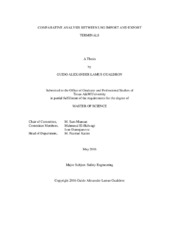| dc.description.abstract | According to the US Energy Information Administration (EIA), the natural gas consumption in the US was 1,726 billion cubic feet in January 2013, and the demand has been increasing rapidly around the world as natural gas becomes the fuel of choice for electric power providers. In order to supply this demand, the US economic interest was focused on the Liquefied Natural Gas (LNG) import terminals installation. However, since 2009, due to dramatic changes in gas production and economy the US has become a net exporter of natural gas.
The interest for minimizing the negative consequences associated with LNG terminals has emerged by focusing on the potential damages that may be generated by the flammable and cryogenic characteristics of LNG such as vapor cloud, flash fires, and pool fires.
LNG research and regulation have been successfully applied for providing safer conditions at the LNG import terminals. However, the integration of export terminals into the existing LNG network requires a thorough revision of the new challenges imposed by the specific conditions related to the liquefaction facilities. It is intended to determine the exclusion zones for these two particular scenarios through the utilization of PHAST in order to estimate the areas where people, property, or the environment would be more severely affected. A revision about the parameters proposed by the normativity for the estimation of the exclusion zones, in contrast to the particular conditions that might affect the plants located on coastal areas is performed.
Additionally, this project seeks to integrate the predicted consequences into real world scenarios by including the implementation of a Geographic Information System (GIS). The georeferenced data will to identify the potential vulnerable areas located near to the LNG facilities.
The main goal intended in this project by the combination of these two computational tools (PHAST model and GIS) is to reduce the gap between the consequence estimation of LNG catastrophic events and the incorporation of these results in a real world environment. | en |


